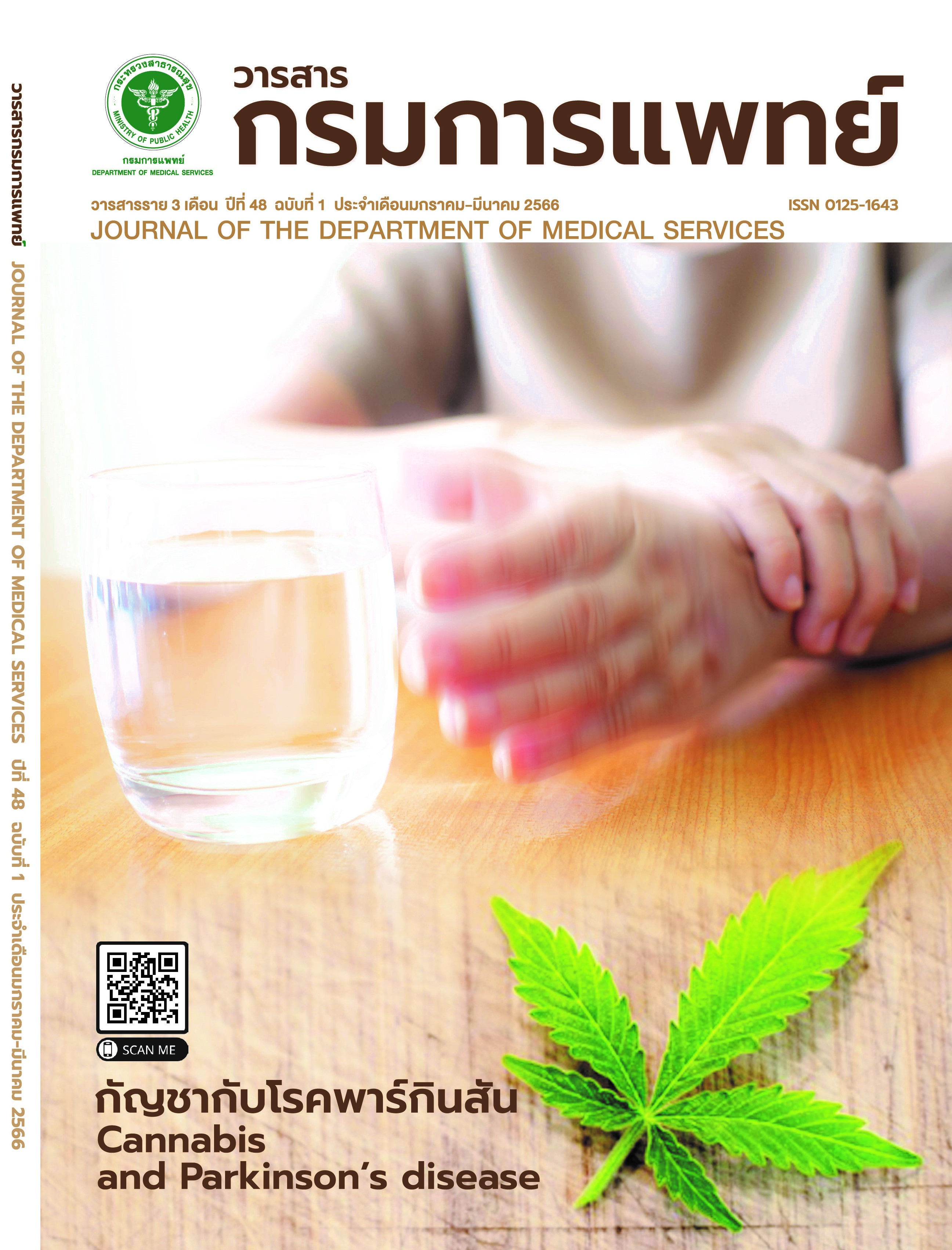Shear Bond Strength between 3D Printing UDMA Denture Base Material and the Hard Relining Material
Keywords:
3D printing UDMA denture base, hard reline materialAbstract
Introduction: A 3D printing UDMA consists of different chemical compositions from hard relining materials.As a result, repairing or relining 3D printing UDMA denture base has been questioned in clinical practice. Objective:This study aimed to compare the shear bond strength between 3D printing UDMA denture base and PMMA denturebase material bond with hard relining materials. Materials and Methods: A total of forty denture base specimens,26 mm in diameter and 10 mm in thickness, were prepared for heat cured PMMA (Vertex®) and UDMA (Optiprint®).They were relined with Unifast trad and Tokuyama rebased II, then thermocycled (5 °C / 55 °C, 2 c/min) for 5,000cycles. A shear bond strength test (MPa) was performed on a universal testing machine. Data were statisticallyanalyzed using a two-way ANOVA analysis, followed by Post hoc Tukey’s test (p < .05). Result: Two-way ANOVAshowed significant differences in the shear bond strength values (p < .05). In addition, Vertex® showed the highestshear bond strength value when relined with Unifast trad® (16.39 ± 3.22 MPa), followed by relined with Tokuyamarebase II® (7.81 ± 2.63 MPa). Optiprint® showed the lowest shear bond strength value when relined with Unifast trad®(4.63 ± 2.13 MPa). Conclusion: The two different denture base types have demonstrated that shear bond strengthvalues are corresponded to various relining materials.
References
National Statistical Offce. Situation of The Thai Elderly 2021.National Statistical Offce; 2021.
Janeva NM, Kovacevska G, Elencevski S, Panchevska S, Mijoska A,Lazarevska B. Advantages of CAD/CAM versus ConventionalComplete Dentures - A Review. Open Access Maced J Med Sci.2018; 6:1498-1502.
Inokoshi M, Kanazawa M, Minakuchi S. Evaluation of a completedenture trial method applying rapid prototyping. Dent Mater J.2012;31:40-6.
Ahmad F, Dent M, Yunus N. Shear bond strength of twochemically different denture base polymers to reline materials.J Prosthodont. 2009; 18:596-602.
Minami H, Suzuki S, Minesaki Y, Kurashige H, Tanaka T. In vitroevaluation of the influence of repairing condition of denturebase resin on the bonding of autopolymerizing resins. J ProsthetDent. 2004; 91:164-70.
Vallittu PK, Ruyter IE. Swelling of poly (methyl methacrylate)resin at the repair joint. Int J Prosthodont. 1997; 10:254-8.
Silva Cde S, Machado AL, Chaves Cde A, Pavarina AC, Vergani CE.Effect of thermal cycling on denture base and autopolymerizingreline resins. J Appl Oral Sci. 2013; 21:219-24.
Matsumura H, Tanoue N, Kawasaki K, Atsuta M. Clinicalevaluation of a chemically cured hard denture relining material.J Oral Rehabil. 2001; 28:640-4.
Mutluay MM, Ruyter IE. Evaluation of adhesion of chairside hardrelining materials to denture base polymers. J Prosthet Dent.2005; 94:445-52.
Arima T, Murata H, Hamada T. Analysis of composition andstructure of hard autopolymerizing reline resins. J Oral Rehabil.1996; 23:346-52.
Palitsch A, Hannig M, Ferger P, Balkenhol M. Bonding of acrylicdenture teeth to MMA/PMMA and light-curing denture basematerials: the role of conditioning liquids. J Dent. 2012; 40:210-21.
Li P, Krämer-Fernandez P, Klink A, Xu Y, Spintzyk S. Repairabilityof a 3D printed denture base polymer: Effects of surfacetreatment and artifcial aging on the shear bond strength. J MechBehav Biomed Mater. 2021; 114:104227.
Gale MS, Darvell BW. Thermal cycling procedures for laboratorytesting of dental restorations. J Dent. 1999; 27:89-99.
Morresi AL, D’Amario M, Capogreco M, Gatto R, Marzo G,D’Arcangelo C, et al. Thermal cycling for restorative materials:does a standardized protocol exist in laboratory testing? Aliterature review. J Mech Behav Biomed Mater. 2014; 29:295-308.
Marra J, de Souza RF, Barbosa DB, Pero AC, Compagnoni MA.Evaluation of the bond strength of denture base resins to acrylicresin teeth: effect of thermocycling. J Prosthodont. 2009; 18:438-43.
Andrade de Freitas SL, Brandt WC, Miranda ME, Vitti RP. Effectof Thermocycling, Teeth, and Polymerization Methods on BondStrength Teeth-Denture Base. Int J Dent. 2018; 2018:2374327.
Choi JJE, Uy CE, Plaksina P, Ramani RS, Ganjigatti R, Waddell JN.Bond Strength of Denture Teeth to Heat-Cured, CAD/CAM and3D Printed Denture Acrylics. J Prosthodont. 2020; 29:415-421.18. Aydin AK, Terzioğlu H, Akinay AE, Ulubayram K, Hasirci N. Bondstrength and failure analysis of lining materials to denture resin.Dent Mater. 1999; 15:211-8.
Downloads
Published
How to Cite
Issue
Section
License
Copyright (c) 2023 Department of Medical Services, Ministry of Public Health

This work is licensed under a Creative Commons Attribution-NonCommercial-NoDerivatives 4.0 International License.
บทความที่ได้รับการตีพิมพ์เป็นลิขสิทธิ์ของกรมการแพทย์ กระทรวงสาธารณสุข
ข้อความและข้อคิดเห็นต่างๆ เป็นของผู้เขียนบทความ ไม่ใช่ความเห็นของกองบรรณาธิการหรือของวารสารกรมการแพทย์



